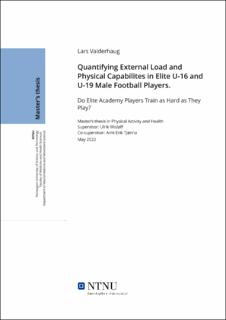| dc.contributor.advisor | Wisløff, Ulrik | |
| dc.contributor.advisor | Tjønna, Arnt-Erik | |
| dc.contributor.author | Valderhaug, Lars | |
| dc.date.accessioned | 2022-08-06T17:19:18Z | |
| dc.date.available | 2022-08-06T17:19:18Z | |
| dc.date.issued | 2022 | |
| dc.identifier | no.ntnu:inspera:105945279:23762426 | |
| dc.identifier.uri | https://hdl.handle.net/11250/3010465 | |
| dc.description.abstract | Hensikt: Hensikten var å kvantifisere og sammenligne ekstern belastning, i tillegg til fysisk kapasitet hos mannelige elite akademi fotballspillere.
Metode: Trettiseks G-16 (n=18, 15.5år, 174.8cm, 68.8kg, 62.9ml/kg/min) og G-19 (n=18, 17.7år, 182.0cm, 74.4kg, 62.3ml/kg/min) utespillere ble kategorisert i posisjoner: midtstopper, sideback, defensive-midtbane, sentral-midtbane, kantspillere, spiss, sentrale-spiller og laterale-spillere. Eksterne belastningen av total distanse (m), høy-hastighets-løp (HSR; m, 14.4-19.8km/t), høy-intensitets-løp (HIR; m, 19.8-25.2km/t), sprint distanse (m, >25.2km/t), antall sprinter (antall >25.2 km/t), distanse over 90% av individuell makshastighet (>90%MV; m), akselerasjoner (>2m/s^2), retardasjoner (>-2m/s^2) ble samlet i kamper og treninger med et 10Hz GPS system. Ekstern kamp- og trenings-belastningen og VO2max, kroppssammensetning, bilateral isokinetisk knestyrke, 30m sprint og 7x30m repetert sprint test (RSA) ble målt og sammenlignet. Trening-Kamp ratio (TMr) ble kalkulert i treningsuker med 1 og 2-kamper. Lineære blandet modell ble brukt i alle sammenligninger.
Resultat: Ekstern belastning varierte basert på posisjon i begge lag: total distanse (0-16%), HSR (11-49%), HIR (22-76%), sprint distanse (60-168%), antall sprinter (100-168%), akselerasjoner (3-29%), retardasjoner (8-52%) og >90%MV (81-167%). Gjennomsnittlig G-19 spiller hadde mer total distanse (4%), akselerasjon (16%), retardasjon (12%) og distanse >90%MV (36%) sammenlignet med den gjennomsnittlige G-16 spilleren (alle, p<0.05). Eksterne belastningen var lavere i 2-kamps-treningsuke sammenligner med en 1-kamps-treningsuke (30-126%, p<0.05). Total distanse, akselerasjon og retardasjon hadde >1TMr, i motsetning til HIR, sprint distanse og >90%MV med <1TMr i begge treningsukene. Gjennomsnittlig G-19 spilleren hadde noe bedre VO2max (3%), knestyrke (9%) og RSA (2%) sammenlignet med den gjennomsnittlige G-16 spilleren. De laterale-spillerne var kjappere i maksimal hastighet (2%), 30m sprint (3%) og RSA (1%) sammenlignet med de sentrale-spillerne som hadde noe høyere VO2max (4%) og knestyrke (10%). Vi observerte en sterk sammenheng mellom antall sprinter i kamp og RSA samt 30m sprint.
Konklusjon: Resultatene fremhever en skjevfordeling mellom kampbelastning og treningsbelastning i aktivitetssonene >19.8km/t. I tillegg fant vi posisjonelle forskjeller i kampbelastning, noe som fremhever viktigheten av trenings spesifisitet. Generelt hadde den gjennomsnittlige U-19 spiller bedre fysisk kapasitet, og antall sprinter i kamp korrelerer sterkt med RSA og 30m sprint.
Nøkkelord: Akademi fotball, kampbelastning, treningsbelastning, fysisk kapasitet | |
| dc.description.abstract | Purpose: The aim was to quantify and compare external load, as well as physical capacities in male elite youth football players.
Methods: Thirty-six U-16 (n=18, 15.5years, 174.8cm, 68.8kg, 62.9ml/kg/min) and U-19 (n=18, 17.7years, 182cm, 74.4kg, 62.3ml/kg/min) outfield footballers were categorized into playing-positions: central-defender, fullback, defensive-midfielder, central-midfielder, wide-midfielder, central-forwards, wide-players, and central-players. The external load: total distance (m), High-speed-Running (HSR; m, 14.4–19.8km/h); High-Intensity-Running (HIR; m, 19.8–25.2km/h; Sprint distance (m, >25.2km/h); Number of sprints (number); distance >90% individual maximal velocity (>90%MV; m) acceleration (>2m/s^2), and deceleration (>-2m/s^2) was collected during matches and training-sessions with a 10Hz GPS system. External load in match and training and VO2max, body composition, bilateral isokinetic knee strength, 30m sprint and 7x30m repeated sprint ability (RSA) were quantified and compared. The training-match ratio (TMr) was calculated in training-weeks with 1- and 2-matches for both teams. Linear mixed model was used in all comparisons.
Results: External match load varied between playing positions for both teams: total distance (0-16%), HSR (11-49%), HIR (22-76%), sprint distance (60-168%), number of sprints (100-168%), acceleration (3-29%), deceleration (8-52%) and >90%MV (81-167%). Mean U-19 player had more total distance (4%), acceleration (16%), deceleration (12%) and distance >90%MV (36%) compared to the mean U-16 player (all, p<0.05). Measured external load was lower in 2-match training-week compared to 1-match training-week (30-126%, p<0.05). Total distance, acceleration and deceleration was >1TMr, whilst HIR, sprint of distance and >90%MV was <1TMr in both training-weeks. Mean U-19 player had greater VO2max (3%), knee strength (9%), and RSA (2%) compared to mean U-16 player. Wide-players was faster in maximal velocity (2%), 30m sprint (3%), RSA (1%) compared to central-players who performed better on VO2max (4%) and knee strength (10%). Correlation between sprints in match and 30m sprint and RSA was observed in U-16(p<0.05).
Conclusion: Results highlights a mismatch between match load and accumulated training load in running-activities >19.8km/h. Also, positional differences in external match load were observed suggesting individual training specificity. The mean U-19 player had somewhat greater physical capacity, and number of sprints in game strongly correlates with RSA and 30m sprint.
Keywords: Youth football, match load, training load, physical capacity | |
| dc.language | eng | |
| dc.publisher | NTNU | |
| dc.title | Quantifying External Load and Physical Capabilities in Elite U-16 and U-19 Male Football Players. Do Elite Academy Players Train as Hard as They Play? | |
| dc.type | Master thesis | |
